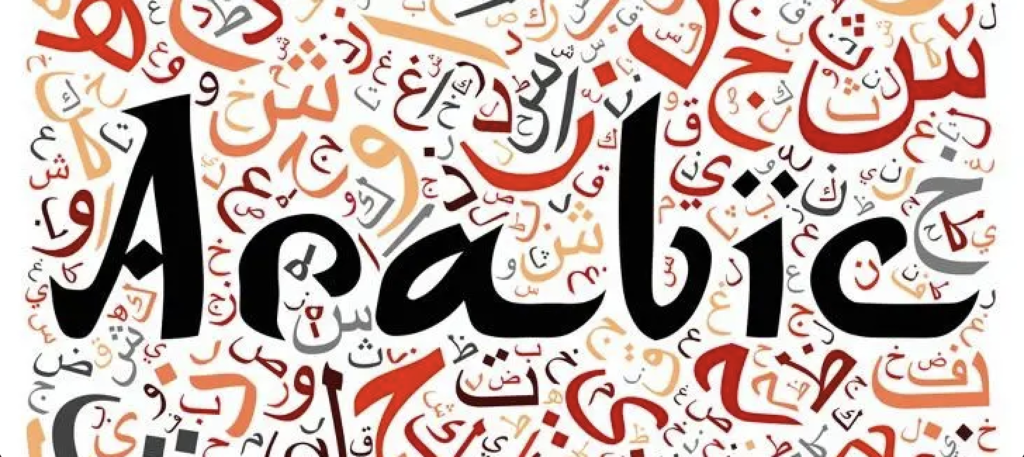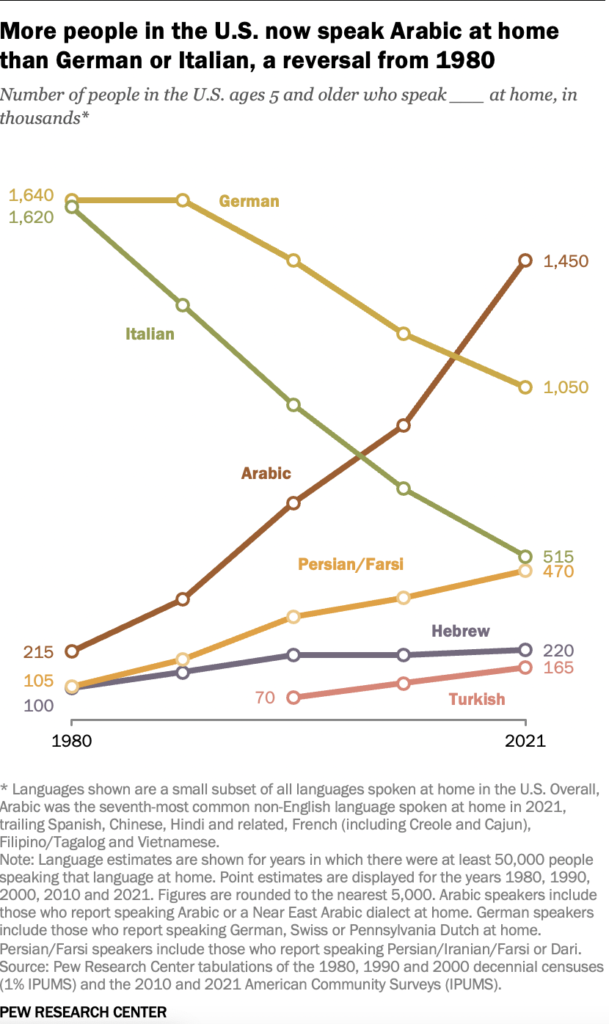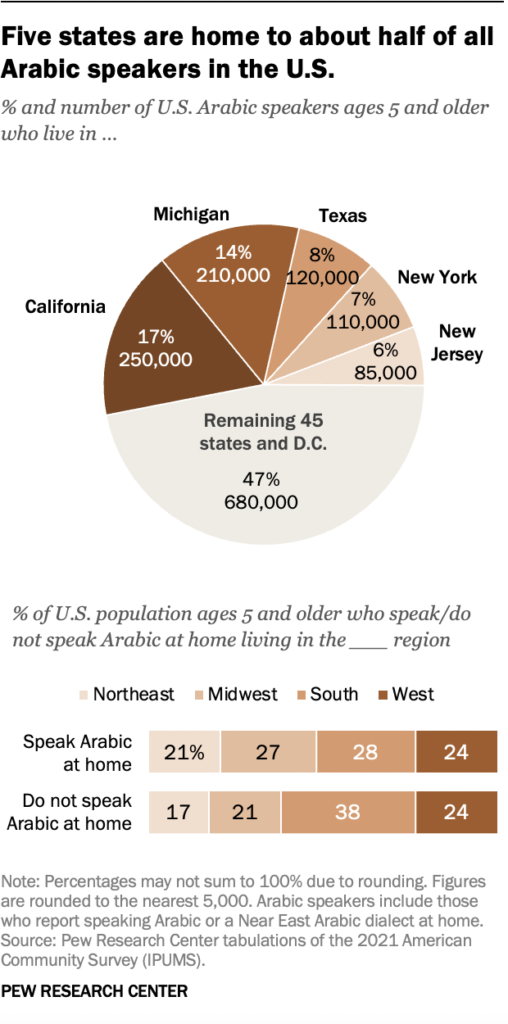United States Seeing Unprecedented Growth in Arabic Speakers

By: Adam Abdel-Qader / Arab America Contributing Writer
The United States has always boasted a radiant tapestry of diverse cultures and multilingual identities. This shining reality is becoming increasingly apparent with the flourishing influx of Arabic speakers in recent years.
The substantial increase in the population of Arabic-speaking individuals emphasizes the necessity of acknowledging and embracing Arab Americans’ contributions to American society. This surge adds depth to America’s linguistic diversity and fosters greater cultural awareness and acceptance among its inhabitants.

Statistics and Causes Behind the Surge in Arabic Speakers:
An article by Mohamad Moslimani at the PEW Research Center titled ‘5 Facts about Arabic Speakers in the U.S.’ reveals an astonishing rise in Americans who speak this beautiful language at home over the past four decades. Today, in the United States, as many as 1.4 million people call Arabic their native tongue; that is a tremendous percentage increase of approximately 551% since 1980 when there were only some meagerly accounted for 215 speakers! The drivers behind such exponential development are thought to be due primarily to varying immigration patterns combined with robust birth rates among Arab Americans. Together these factors catalyze America’s impressive and expanding diversity, especially regarding individuals of Arab descent.
There are a multitude of reasons that can be attributed to this rise in Arabic speakers in the United States. One limelight factor is the persistent political instability in some regions spanning the MENA (Middle East and North Africa) region, prompting many refugees and immigrants to migrate towards a promising prospect of residing within the United States. Moreover, Arab families in America have experienced more frequent offspring than many other demographic groups, resulting in an upswing in national population figures.
Furthermore, there has always been a growing interest among non-Arabic-speaking individuals in mastering the Arabic language. It is a desirable language for many individuals because of its beauty, uniqueness, and economic and political aspects on the global forum. Upon analyzing statistical data about the fastest-growing non-English languages spoken throughout American households, it becomes apparent that Arabic is a significant language among them. According to 2019 government Census statistics, the top five non-English languages spoken in U.S. homes start with Spanish, which leads with 41 million speakers, followed by Chinese (3.5 million) and Tagalog (1.7 million), and finally, Vietnamese (1.5 million). Arabic has emerged as a significant player among these languages, as it sits on the list at number five, with 1.2 million speakers.

Arabic Speakers and a Need for Adaptation:
This recent rise in the Arabic-speaking populace has generated an augmented need for language resources tailored to the higher demands of Arabic-speaking students in the United States. Schools nationwide have responded by offering more Arabic classes, while community-based establishments have emerged, assisting fresh immigrants grappling with English insufficiencies. Notably, corporations have also acknowledged the potential presented by this burgeoning demographic and therefore have introduced products and services precisely designed and targeted toward Arabs and Arab Americans who speak Arabic.
Acknowledging that a vast array of diversity exists within the expanding demographic of the American population is imperative. Within Arabic speakers, there lies a similar trend. More than twenty regional dialects differ significantly and can even render mutual unintelligibility depending on the dialect one knows. Variations in language among Arab-speaking individuals residing in America rely heavily on factors such as origin country and local cultural norms (Ex. Morrocan Arabic vs. Levantine Arabic). This intricate complexity imbues the already multifaceted linguistic tapestry across the United States with additional nuance and depth, adding to the extraordinary diversity among Arab Americans.

A Look Toward the Future:
As we look toward the future, the impact of Arabic speakers will continue to expand across diverse facets of American life. Specifically, individuals belonging to the Arab American ethnicity have made significant strides in domains such as science, mathematics, technology, engineering, law, arts, business, philanthropy, and much more. As more and more Arabic-speaking individuals progressively assimilate into American society on a larger scale, they will begin to contribute unique and advantageous viewpoints, facilitating an improved sense of cultural awareness between communities with differing ethnicities and experiences.
In light of all the upward-spiking trends regarding Arabic speakers, policymakers and educators must recognize the distinctive requirements and difficulties that will come with an everlasting and ever-growing demographic. This notion necessitates implementing policy measures such as promoting bilingualism via innovative and interactive language programs, providing culturally sensitive healthcare services, and advocating for adequate representation within government bodies that cater to Arabs and Arabic speakers navigating their new lives in America.
Undertaking such initiatives will ensure that our country can sustain its status as a vibrant and all-embracing melting pot where individuals, irrespective of linguistic or ethnic background, can feel valued, assisted, and represented equally.
Conclusion:
The increasing number of Arabic speakers in the United States represents a significant societal shift. We must acknowledge Arabic-speaking individuals’ contributions, support them as our nation becomes more diverse, and strive to enhance America’s cultural richness while upholding our globally inclusive reputation as the “melting pot” of cultures. Celebrating this diversity calls for adopting a profound sense of inclusivity by valuing distinct backgrounds and recognizing that linguistic differences aren’t obstacles; they are indications of multiplicity, triumph, and wisdom.
Check out Arab America’s blog here!








